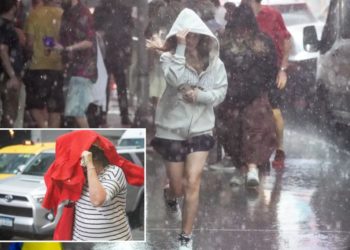Crayweed, a large, golden-brown seaweed, found along Australia’s southeastern coast, plays a crucial role in ocean health. Its underwater forests capture carbon, create shelter for marine species and serve as a nursery for creatures like abalone and rock lobsters.
Once widespread along Sydney’s coastline, it disappeared from a 70-kilometer stretch around the 1980s, at a time when sewage was being discharged into the sea, according to Operation Crayweed. The conservation initiative, primarily run by scientists from universities and research institutes, aims to restore 60 hectares of forest in shallow rocky reef habitats.
“We’re not just bringing back one species, we’re building an entire ecosystem,” says Dr. Adriana Vergés, a professor of marine ecology at the University of New South Wales Sydney, and co-founder of Operation Crayweed.
Improvements in sewage disposal mean the water around Sydney has become clean enough to support crayweed, according to the group, but for it to make a return, it must first be planted and then successfully reproduce.
At designated restoration sites, scientists and volunteers attach healthy male and female crayweed collected from wild populations onto biodegradable mats fixed to reefs.
Crayweed reproduces when male plants release sperm into the water, which fertilizes eggs from the female plant. These fertilized eggs grow into young crayweed, known as “craybies,” which anchor to the seafloor and grow into new forests.
Once established, the mats are removed, and the forest continues to grow and spread on its own.
Since Operation Crayweed began over a decade ago, it has targeted 16 sites along Sydney’s reefs, seven of which now have established self-sustaining crayweed populations. The restored forests cover over two hectares, and microscopic animals are already returning, according to Vergés.
Three new sites, Lurline Bay, Dee Why, and South Maroubra, were added in 2024. Dee Why alone jumped from just 10 crayweed plants to 466 juvenile crayweed in a single year and by early 2025, more than 1,500 craybies had established themselves at South Maroubra, according to Operation Crayweed.
“I get a real kick out of seeing it. And now it’s expanded so much that you can see it even without getting in the water,” says Vergés. “When the tide is low, you can see the crayweed swaying as the water pulls away from the coast.”
The team plans to restore 10 more sites in the next two and a half years.
Dr. Prue Francis, a senior lecturer in marine science at Deakin University, who isn’t part of Operation Crayweed, says the project can have a wider impact in the area.
“People often focus on the dramatic bleaching of coral reefs, but with kelp forests, the decline is quieter, until it’s too late. These underwater forests are supporting a whole ecosystem. When they’re gone, like in parts of Sydney where crayweed has vanished, nothing grows back,” she told CNN.
“Restoration efforts like Operation Crayweed aren’t just about bringing back seaweed, they’re about saving an entire web of life that depends on it,” she added.
Science’s new frontier
As well as planting crayweed, the team is using advanced techniques to help it survive in a world where climate change is making oceans warmer, and environmental conditions more extreme.
It has successfully mixed genetic populations sourced from north and south of Sydney, which enables the restored populations to reflect the natural genetic diversity and structure of healthy existing populations — “an important innovation,” says Vergés — and is testing whether crayweed genetics or its microbes (tiny living organisms that live on its surface) play a greater role in helping it survive rising ocean temperatures.
The team is also looking to build up a “biobank” of crayweed populations as a contingency in case they are wiped out by a heatwave.
“In Western Australia, such a marine heatwave erased entire crayweed populations. To prevent similar losses, we are turning to cryopreservation,” says Vergés. “We collect the sperm and eggs from different populations and freeze them at ultra-low temperatures.”
While other kelp species have been cryopreserved in research labs around the world, no one had successfully applied the method to crayweed, says Catalina Musrri Fuenzalida, who is working on freezing efforts as part of her PhD at the University of Sydney.
“We don’t have any genotypes or biobanks for these species,” she explained. “So, if we lose a population, it’s gone forever.”
Beyond the technical challenge, the work has a deeper meaning for Musrri Fuenzalida: “Sometimes, as a young scientist, it’s hard not to feel hopeless. But this feels like something real, something that can make a difference,” she says. “It gives you hope.”
The efforts of Operation Crayweed are part of wider global efforts to recover lost kelp habitat. The Kelp Forest Challenge aims to restore four million hectares of kelp globally by 2040.
For Vergés, the success of the project is both scientific and personal. “I swim in the ocean on weekends, and everywhere I go now, I see crayweed again,” she says. “It was gone, and it never would’ve come back by itself.”
Correction: This story has been updated to correct the name of Catalina Musrri Fuenzalida.
The post Lost underwater forests are returning to Sydney’s coastline appeared first on CNN.




